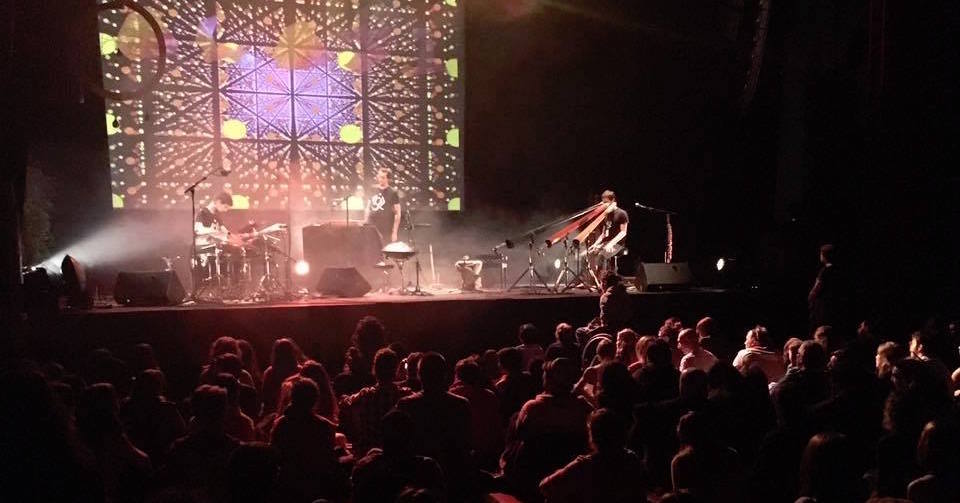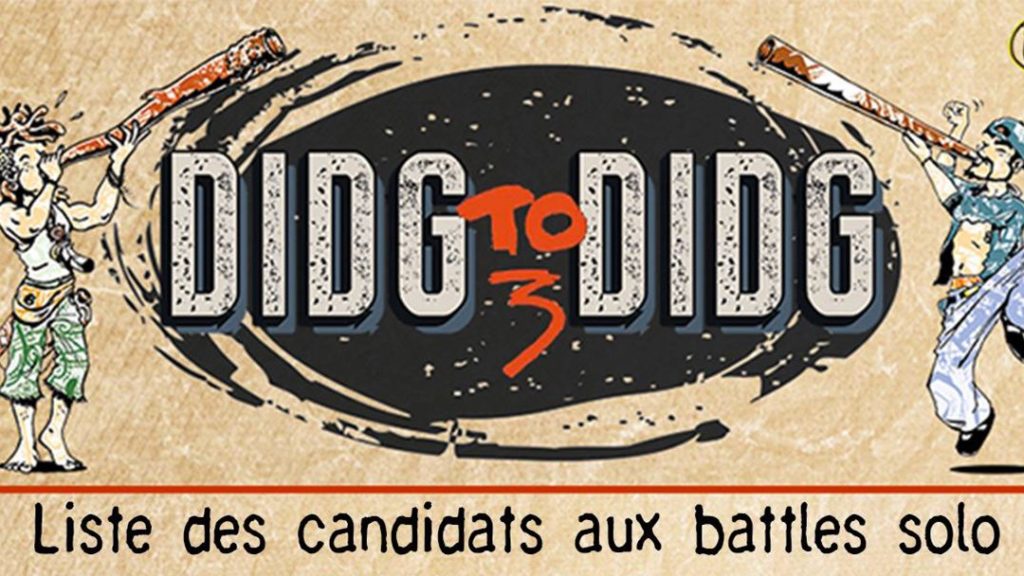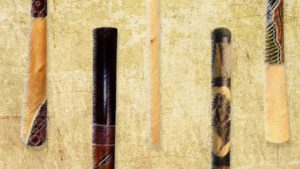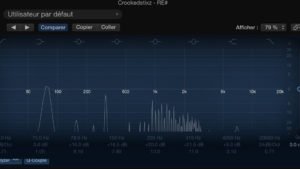Since 2013 the Didg to Didg takes place every year. The great atmosphere is guaranteed and the benefits to the didgeridoo community are plenty. However, the competition format of the event makes for some unavoidable pitfalls…
Just like many didgeridoo players, I was in Poitiers (France) in 2016 for the third edition of the Didg to Didg. I attended out of curiosity, in order to form an opinion about an event I wasn’t necessarily keen on.
Well, I might as well go straight to the point: even if I was happy to see certain people (hello you !) those two days did not necessarily make me change my mind about it.
I wrote this article then in order to share my impressions and get yours. And even if the Didg to Didg is not exactly my cup of tea, to categorically reject it would mean to ignore the beautiful qualities it brought into the didgeridoo world.
A little summary of impressions after two days of « battles » follows.
The undeniable advantages for the didgeridoo community…
To get together and federate the didgeridoo community
On Earth, (yes, all over the planet!) the didgeridoo world remains pretty confidential. France, despite being one of the most active countries in the scene, has only 3 festivals dedicated to our beloved instrument: “Le rêve de l’Aborigène“, Nomadidge and the “Tribal Elek“.
The Didg to Didg has then come to complete the picture. Just like any other gathering of passionate people, it enables lots of players to connect, meet, and federate. The interesting thing being that the connections happen well beyond the French borders.
This year for instance, 9 nationalities were represented. And the best of all is that the number is set to rise edition after edition.
In times like these, when the world nations meet and seek one another, all we can do is honour this kind of initiative!
Didg 2 Didg : What is the principle ?
It works just like any Beat Box battle. The event begins with the qualifying rounds, where 32 players play on stage in sequences of 3 minutes each.
Towards the end of the afternoon, 16 candidates are selected for the next round that takes place the following day. This is when the « proper battles » begin…
Two players compete against each other by playing two sessions of 1.30 minutes each. The jury then votes based on a set of criteria such as originality of performance or yet stage presence. Only one player is chosen for the quarter finals and the same principle applies till the finals.
Sharing and improving didgeridoo techniques
I personally did not attend the first two Didg to Didg editions, but judging by what most « regulars » say, the level has only improved year after year.
It goes without saying then that the competition side of the event spurs real motivation to excel among players, proving that there’s undoubtedly some advantages to it. And challenge (in moderation) remains a healthy motivation in order to play the didgeridoo!
Plus, the Didg to Didg enables meeting new people and sharing, becoming the perfect cocktail in order to get better!
Mingling
In 15 years France has seen a great deal of progress when it comes to didgeridoo playing, and this is thanks to the emulation created by a certain number of factors.
In 2002, the first edition of “The Aboriginal dream” was born in Airvault. A year later, Lyon hosted the first French gathering of didgeridoo players, where players from Lyon and Dijon reunited at Lyon’s Croix-Rousse. The following years several workshops were organised and associations created.
The Didg to Didg fits into this evolution perfectly, enabling to nurture motivation around European didgeridoo playing.

Gigs of Oloji, thanks to Othello Ravez to invite me for a great duet !
There’s always a catch though…
A competition remains a competition
That being said, it’s not all roses and I couldn’t help but notice certain downfalls to the event. Even if the Didg to didg is extremely welcoming and friendly (with emphasis on “extremely”!) it still remains a competition. There’s subsequently a winner and rather several losers. I could see how devastated players were at being eliminated.
It’s important to notice though that the organisers do their very best in order to explain the reasons why unsuccessful players did not qualify, helping them learn from their mistakes and make progress. Despite everything, the contest still appoints a winner and quite a few losers.
Would « battles » do little for music?
If we translate battle into French we get « combat » (combat: n. a fight, struggle, or controversy, as between two persons, teams, or ideas). Just a tad heavy for music!
Words are indeed powerful and the term « combat » is far from insignificant.
And yes, let’s rest assured, battles are rather friendly, but I can’t really say I heard a lot of music played in those performances!
Skills and rhythm were there, sure, but in my opinion few players contributed much in terms of music. The didgeridoo remained merely an instrument at the service of technique.
That’s why I admired the audacity of Babu, who dared to play traditional in the semi-finals. Well done Babu, what a beautiful present!
An event for the didgeridoo passionates
Beyond the technique, the actual catch is playing for real didgeridoo passionates. Note that we’re talking about didgeridoo players playing for didgeridoo players here. This is, in my opinion the main trap.
And that is because a community, be it a didgeridoo one or that of Galapagos gray marmots, brings out great qualities such as listening, mutual help, understanding (don’t know if it’s the case for the marmots though!)
However, the thing is that members of the same group end up playing for their own community, ignoring the rest of the world. So we play just for other didgeridoo players here, forgetting the 7 billion other individuals around.
Blunt as it may sound, I still believe there’s some truth behind it all…
The final of Didg 2 Didg in 2015 in Grenoble (France). Joao Vs Tom B !
Some advice for the competitive didgeridoo players
Even if I’m not a big fan of these kinds of events, here are some titbits that might come in handy for all those who would love to try their luck at the Didg to Didg one day !
The evolution of rhythms
During the qualifying rounds and battles, we usually had 2 configurations: The player set his rhythm from the start and we knew that it was unlikely to change throughout the performance. Players started off slowly just to end up setting a rhythm and keeping the pattern till the end of the piece. In both cases, there were no surprises. So if you’re competing, go beyond this mindset and surprise your audience (and the jury!). Everybody loves a surprise. 🙂
Improving the transitions
Even if rhythms didn’t change much, from time to time transitions did happen. And they rather made you lose track of the piece, be it because the tempo was modified or because the rhythmic structure was broken. It’d be a great idea then to work on everything related to break transition and pace with our old friend the metronome. Again and again!
Whatever happened to harmonics?
According to the latest reports, they’re at Bora Bora enjoying life! Nobody wants them anyways so they’re having a well-deserved holiday. 🙂 I thought that maybe, with time, our beloved harmonics would be a little bit more valued, but speed (read breathing mastery) has largely been preferred by players. The beauty of harmonics and the precision of attacks (namely the extent to which a note is hit) are neglected. That remains coherent though with the competition format: as long as we pretend to impress with a didgeridoo, speed will always win. Poetry though is more discrete, however it creates elegance and that remarkable subtlety that certainly knows how to reach hearts. Fellow players, practice your overtones and the clarity of your sound and become poet battlers!
In conclusion: Didg 2 Didg, a friendly battle
Once more, no Didg to Didg bashing here, I’m just sharing my point of view and encouraging the exchange of ideas on the subject. Today, the didgeridoo world is heavily influenced by the spirit of beatbox and the Didg to Didg certainly meets an expectation from a number of players. This said, I’d have truly loved listening to a Stephen Kent or a Denra Durr in those battles! That would have made for a beautiful and rather audacious surprise! Still, hats off to the association « Sur 1 Air 2 didg » which did a wonderful job organising the event and to Zalem, for coming up with the idea that encourages so many players. Congratulations to Tiago Francisquinho on his solo victory as well, and to Julien Henneveux and Adrien B. Prana for their duo Underground cosmic didgs thanks to which they won the duo contest. And just want to end by saying that the main thing is that everyone live his music (and life!) with sincerity, simplicity and generosity.
If what I say resonates with you and have any comments or ideas, please share them below! That will contribute to the overall debate. And of course if you feel like it, share this article!












